by Amineddoleh & Associates LLC | Apr 22, 2023 |
Anyone who has been a student knows that the fastest way to capture someone’s attention in a noisy cafeteria is to start a food fight. Last summer and fall, something similar happened in the art world, as museums became the backdrop for messy protests. Now, after a short repose, the culprits are at it again. This time, the action is taking place in Italy, with the most recent attack on art having occurred on March 17th in Florence.
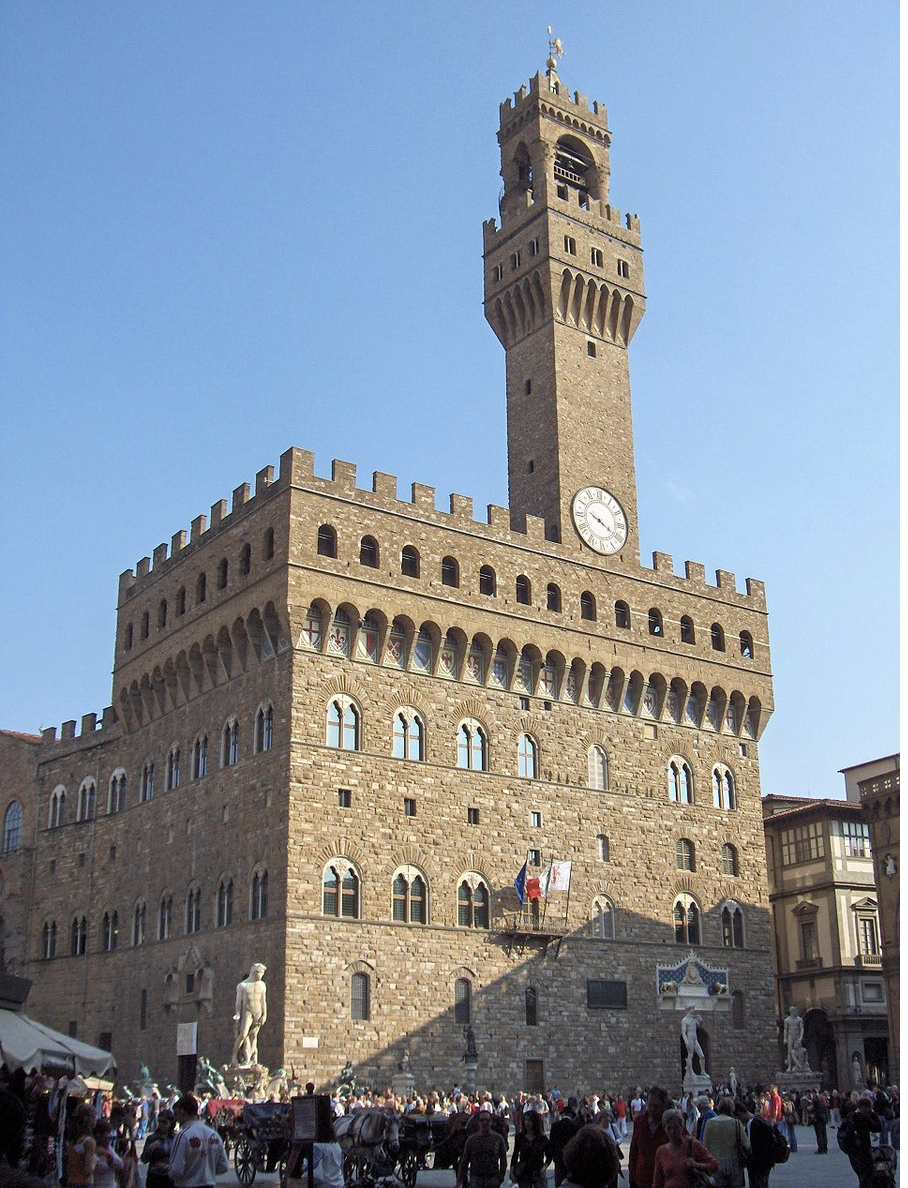
Palazzo Vecchio, Florence, Italy. Image via JoJan through Wikimedia Commons.
Wait, What’s Going On?
The targets are priceless pieces of art and cultural heritage. The culprits are climate activists from several distinct groups with the same singular message: pay attention to climate change. The settings are (formerly) peaceful, as in this last attack in Florence.
In Florence, climate activists disrupted an ordinary day by spraying paint over the outer walls of Palazzo Vecchio. That attack on cultural heritage comes on the heels of the destructive actions taken against artwork in museums around the globe. Soup, cake, ink, and even super glue have been haphazardly applied to the most famous works of art in museums’ prized collections within the past year.
Many of these attacks occurred last summer and fall. Then, around the New Year, there was a brief repose. Art world insiders were optimistic that this trend would stop entirely. Time Magazine reported earlier this year that one major group, Extinction Rebellion, had announced a shift away from flashy civil resistance tactics to gain support for their cause. Instead, the group stated their plan to devote energy to large-scale protests that do not break the law. If other climate change groups followed suit, this would mean a dramatic departure from the ink-splattering and soup-slinging tactics directed at fragile pieces of art and cultural heritage.
Unfortunately, a change in tactics does not seem to be the cards. Not only was the fear that these attacks would continue realized by the recent protest in Italy, a quick check-in with the notorious Just Stop Oil climate activist group – of art attack fame – confirmed their general intention to carry on with the practices of last year. The group, in response to Extinction Rebellion’s statement, promised to “escalate” their actions of civil resistance and public disruption. The group even threatened to begin slashing famous paintings – yikes!
First Rule of Fight Climate-Change Club: Talk as Much as You Can About Fight Climate-Change Club
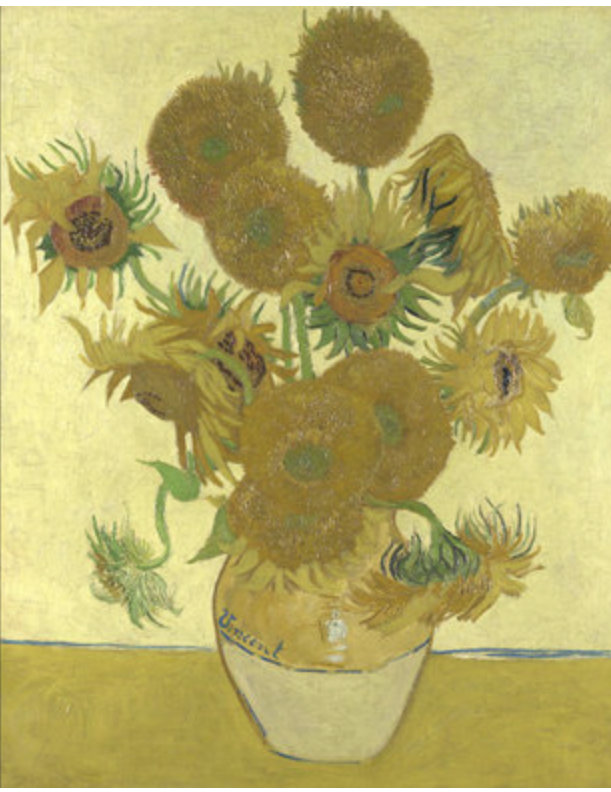
Van Gogh, Sunflowers, 1888. On view at The National Gallery, London.
The purpose of these art attacks is to get people talking. One recent attack last November was from a group called Last Generation Austria, in protest of Austria’s reliance on fossil fuels. Two activists threw black liquid (presumably representing oil) at the delicate 1915 painting Death and Life (1915) by Gustav Klimt. One activist was promptly removed from the scene by security. The second succeeded in gluing his hand to the glass panel encasing Klimt’s valuable painting. This gluing action was a serious risk both to the safety of the dizzyingly priceless piece of cultural heritage behind the glass, and to the climate activist’s personal hand health. It seems the activist cared very much for climate change, but very little for his hand.
The above attack was likely inspired by the group that finds itself the major instigator of this global operation. Just Stop Oil (the O.G. art attack tribe of climate protestors) has been at this game since earlier last summer. The most publicized attack by Just Stop Oil featured a pair of activists throwing tomato soup at Vincent van Gogh’s Sunflowers. During the attack, two 21-year old activists leaped over the velvet ropes stationed in front of Van Gogh’s painting, removed their jackets to reveal matching “Just Stop Oil” t-shirts, and slapped soup onto the painting. Not only is this display of wanton disregard shocking, but it boggles the mind that the target of the soup-based attack was not a Warhol work!
The attack seems to be connected to another recent event of art vandalism that took place that same month in the National Gallery of Australia. That incident involved members of a different group, Stop Fossil Fuels, scribbling ink on Andy Warhol’s screen prints of soup cans. The similarities cannot be ignored, as they follow a similar attention-mongering logic. However, why Just Stop Oil applied soup to varnish, while Stop Fossil Fuels applied varnish to soup, is a total mystery.
The above examples are merely a sampling of the demonstrative protests that have occurred in major museums since the beginning of the summer. They all follow a similar pattern: either a defacing with food or liquid, or protestors gluing themselves to a frame or glass. The latter is an imitation of the form of “locking” protest, in which activists will chain themselves to a stationary object to make it more difficult to be removed by authorities.
Fortunately, it seems that the works involved were unharmed, since they are protected by glass and other protective casings applied by art conservators. In the case of Just Stop Oil and Sunflowers, it was publicly known that the tomato soup would not damage the painting (according to Emma Brown, the founder of Just Stop Oil). Brown asserts that her group’s motivation has never been to destroy art. Rather, it is to engage in a conversation about why damaged artwork incites rage, while news reports of climate change do not.
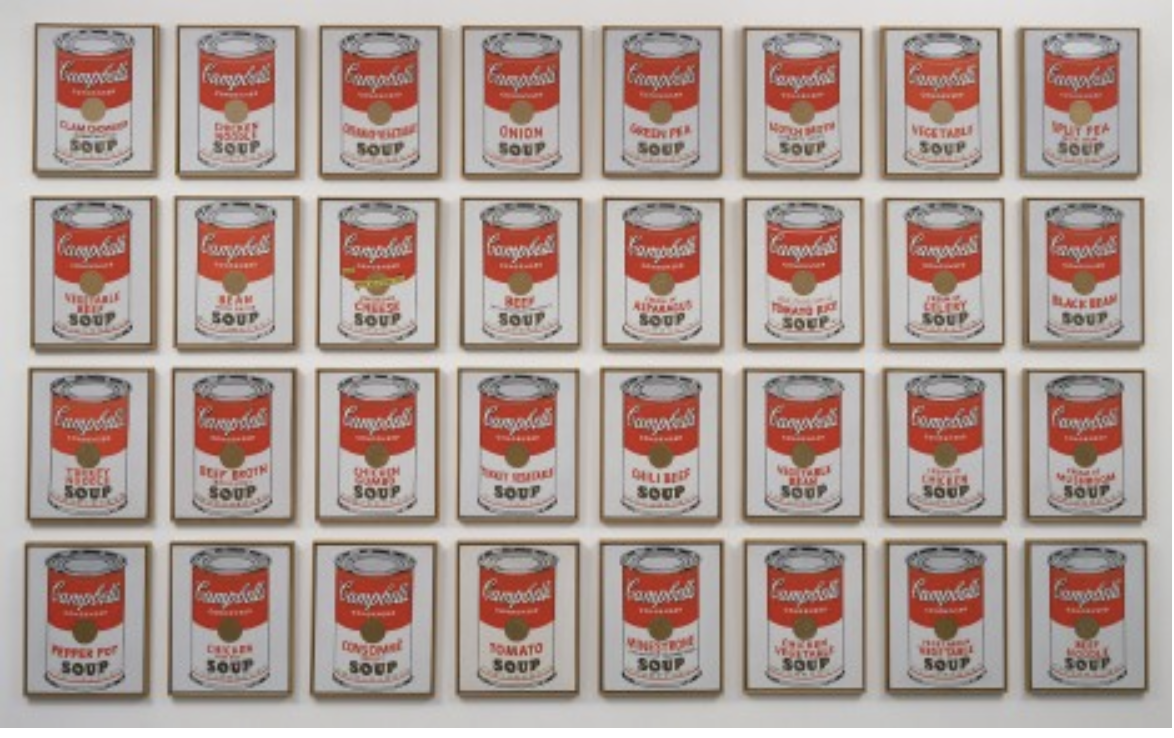
Andy Warhol, Campbell’s Soup Cans (1962). Image via AP News.
This is not an illogical question, when framed in the proper context. However, when news reports of food being thrown in national galleries are splayed across individual computer screens, the intentions of Just Stop Oil’s efforts are lost in the absurdity of the situation. Food throwing, it seems, is better left in the era of summer camp hijinks.
It seems that the message may have been lost on the public, and that the method of protest may be too radical. In this way, they may be ostracizing potential friends of the cause by turning them off with their flamboyant and messy displays of passion. This would result in the activists seeming to be more like vandals to be avoided, rather than potential friends to be admired.
In fact, these stunts create animosity with museums and the public. By using art to stage protests, museums are now heightening security, leading to a less personal experience at art institutions. Increased security measures and the temporary removal and cleaning of artworks is an added expense for our public institutions. After significant drops in revenue during COVID pandemic, the last thing museums need is to waste funds cleaning up after these messy stunts.
Iconoclasm and Art Vandalism
Just Stop Oil’s flashy protests are not the first instances of art vandalism, nor will they be the last, as art vandalism has a long history of activists using destruction to send a political message. Dr. Stacy Boldrick, author of Iconoclasm and the Museum, explores the history of iconoclasm, which she defines as “image-breaking.” Public perception of iconoclasm influences how the broken image enters a culture’s consciousness, which can result in an almost secondary, separate work of art that begins a life of its own. Even if the piece is restored to its original glory, photos of the work in its defaced form become famous symbols of a particular political movement.
An example of this is none other than the famous Rokeby Venus, and its slashing by suffragette Mary Richardson in protest of the oppression of women. Readers of the blog will recall our firm’s piece on work (for a refresher, click here), and its haunted provenance. The history of the work influenced newspapers of the time to claim Richardson was acting from psychosis induced by Venus’s beauty. Boldrick, on the other hand, makes an argument for Richardson as a legitimate defender of the rights of women, though one who took her message to the extreme. Setting Richardson’s mental state aside, the images of the slashed Rokeby Venus are nearly as impactful as the restored version. The photos of the slashed painting draw the eye toward the ostentatiousness of Venus’s body, framing the voluptuous woman in a context of forced femininity.
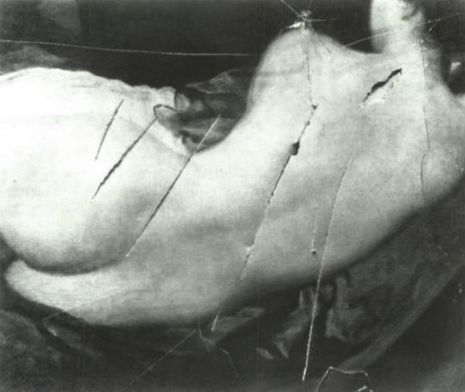
The slashed Rokeby Venus. Image via artinsociety.com
Another example of a defaced work sparking its own conversation occurred following artist Tony Shafrazi’s 1974 defacing of Picasso’s Guernica. Shafrazi strode up to Guernica and spray painted “KILL LIES ALL” across the piece, in protest of America’s involvement in the Vietnam War. Fortunately, the painting itself was protected by a heavy coat of varnish. Museum curators were able to quickly clean off the spray paint. Even so, the photos of the defaced work, prior to the cleaning, became political messages. Moreover, Shafrazi himself went on to use the fame garnered by his demonstration to fuel his own artistic career. He is currently still doing well as a successful gallery owner and art dealer in New York.
Shafrazi proves that images of defaced art can send a cultural message by spreading the agenda of the activist who vandalized the work. However, sending a message does not always result in actual change on an individual level. If activists truly desire to change public behavior, there are more effective ways to evoke such action – ways that do not involve defacing fragile, famous works of art. Additionally, museums themselves can take action to promote sustainable, collaborative conversations with activist groups, all while keeping the art safe (and away from tomato soup).
Special Exhibitions
The North Carolina Museum of Art put on an exhibition this past summer that would have appealed to Just Stop Oil’s team of activists, because the show featured artists whose work brings attention to the dangers of climate change. The show, Fault Lines: Art and the Environment, featured artists such as Willie Cole, who did a site-specific installation of a chandelier made entirely out of single-use plastic water bottles. Another artist, Richard Mosse, exhibited works that used infrared technology applied to aerial photographs of geological locations to raise awareness of issues such as deforestation. Featured works of Mosse included: Aluminum Refinery, Paraguay; Burnt Pantanal III; Juvencio’s Mine, Paraguay; and Subterranean Fire, Pantanal.

Richard Mosse, Girl From the North Country, 2015. Image via artsy.net.
Also shown in the exhibit were works created by sisters Margaret Wertheim and Christine Wertheim, whose whimsical crocheted coral reef draws attention to the devastating impact of climate change and plastic trash on the lives of coal reefs. The sisters also did an installation called The Midden, which was constructed of the trash the duo collected walking on the beach over a period of four years.
This writer, a visitor of the exhibit, was particularly influenced by the Wertheim’s trash collecting piece and by the plastic bottle chandelier by Cole. As the writer herself was sipping from a single-use plastic bottle, she was made aware of her personal impact on climate change as a visitor of the exhibit. The writer immediately vowed to use reusable water bottles from that moment on. She joined others on the way out of the exhibit in pledging to reduce all single-use plastics by dropping a recyclable token into the glass canister provided by the front door.
The purpose of the exhibit was to use video, photography, sculpture, and mixed-media works to offer new perspectives in addressing urgent environmental issues. The exhibit highlighted the consequences of inaction, while providing opportunities for patrons to take their own steps towards sustainable environmental stewardship and restoration. This resulted in a celebration of the creation, rather than the destruction, of art in its fullest capacity to send a message to society. By focusing on creation, patrons were encouraged to be part of a constructive solution to climate change alongside the artist activists who produced the pieces shown in the gallery. When asked how about the public response to the exhibit, Virginia Ambar, Assistant Director of Ticketing and Visitor Experience at NCMA said this: “Many people commented on how important it is to highlight our collective roles in affecting our environment and that the exhibit did that in ways that were both startling and beautiful.”
Museum Joint Statement
One way museums have been guarding themselves against art attacks has been to increase private security methods on museum grounds. These increased security measures have taken the form of additional guards, added cameras, and metal detectors – which all come with their own costs. Increasing security is a pricey endeavor, and not one that most museums have the budget for, particularly coming out of the hardships museums faced during the pandemic lockdowns.
Another option is for major public institutions to continue releasing joint statements concerning these matters. The International Council of Museums (ICOM) released a statement signed by over 90 museum leaders. Included among the high-profile supporters were figures from the Prado, the Guggenheim, the British Museum, and the Metropolitan Museum of Art. The statement explains the precariousness of the art being targeted, and highlights the vulnerability of delicate works of art, even when they are protected behind glass. While the statement does not address the issues raised by climate change, it does draw a clear line in the sand to draw attention to the riskiness of targeting these fragile and irreplaceable treasures.

Climate protestors march through city centers, causing traffic delays. Image via juststopoil.org
It is a showing of museum solidarity against protests. Its impact is yet to be seen, but there is hope that the statement will have an impact on protestors. The breadth of the ICOM statement, combined with the released statement by the American Association of Museum Directors on the same topic, last year, might speak to the protestors in a way that results in fewer art attacks. Taken together, the statements serve to highlight the damage caused by targeting art and the vulnerability of objects used in protests, without casting judgment on the protestors’ message. Rather, these statements encourage compassion on a global scale. Being good stewards of art and advocates for the environment both involve recognizing ways to nurture our shared humanity.
Conclusion
Collaboration is a better way forward than flashy protests. The lifespan of a shocking protest is only that of the flash-in-the-pan clickbait headline. As such, the political messaging of Just Stop Oil continues to be lost in the noise of the internet. Moreover, the fact of the matter is that throwing food at art to send a message is not sustainable. The shock value wears off eventually. It also wastes food and paint, not to mention the environmental impact of cleaning up the destruction. Remember the Italian climate activists’ recent activity in Florence? Ironically, even their spray painting seems to have caused more environmental harm than good. Nardella, the mayor of Florence, reported that “more than 5,000 liters of water were consumed to clean up Palazzo Vecchio” following the destructive protest.
Art, on the other hand, is constantly reinventing itself in sustainable ways that are fresh and exciting. Because of art’s evolving nature, activists who choose to work with artists and museums in a constructive, rather than a destructive, way, have the potential to sustainably effect real social change.
It’s a framework for elevated discourse. It smells like progress, not tomato soup.
by Amineddoleh & Associates LLC | Apr 13, 2023 |
At 6:30pm on Monday evening, April 15, 2019, the Cathedral of Notre-Dame de Paris began to burn.

Notre-Dame Cathedral’s spire on fire on April 15, 2019. Image courtesy Antoninnnnn via Wikimedia Commons.
Considered a jewel of Gothic architecture, the inferno began in what has been referred to as the “forest” of wooden beams inside the Cathedral’s roof. These beams caught fire and collapsed – a big issue, because the wooden forest of beams had provided much-needed support for the entire structure. After the beams disintegrated, the Cathedral crumbled. Onlookers, who yearned for the building to be saved from disaster, lost hope. As the Cathedral sank, smoke and dust rose to overtake the horizon.
Four years later, the darkness has cleared and hope abounds. The shock felt by millions around the world has softened, and the Cathedral’s on-going renovation is chugging along like the Little Engine that Could.
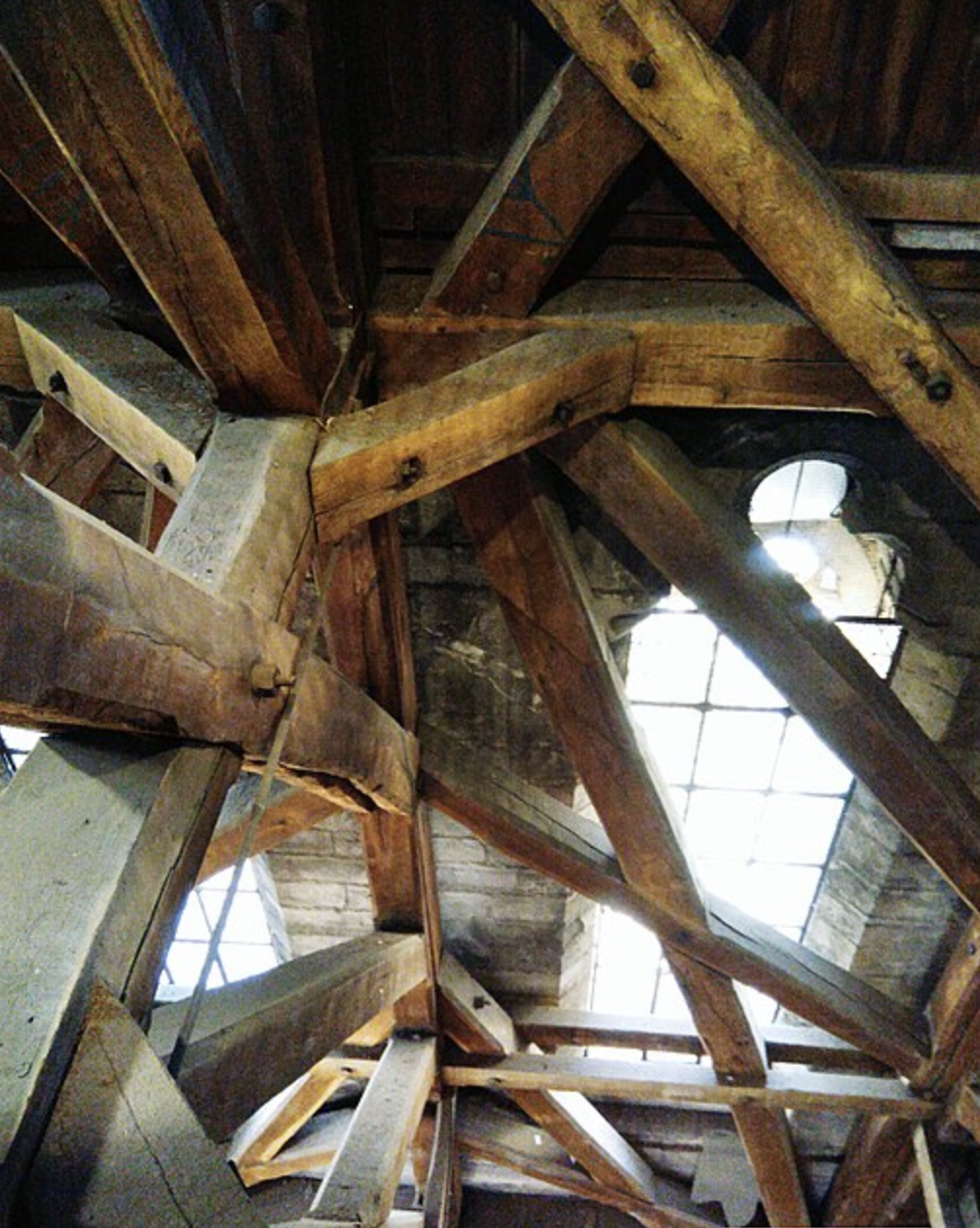
The inner framework of Notre-Dame, just months before the 2019 fire. Image courtesy SamuelPrr14 via Wikimedia Commons.
However, this chugging along is certainly that – a slow, steady pace. Originally, an anticipated re-opening date was set for April 19, 2024. This date would have been ideal as it is the fifth anniversary of the fire. Yet, due to delays, that plan has been scrapped. Several things have gotten in the way of the original timeframe (two major ones being a global pandemic and the outbreak of war in Ukraine).
Renovators, seeing that the finish line was not quite in sight to make that deadline, made adjustments. “Plan B” was to have the project finished by the summer of 2024. This would have meant that the reveal of refreshed cathedral would coincide with Paris’s highly anticipated 2024 Summer Olympic Games. Unfortunately, that plan has also been scrapped and tossed in the rubble. The newest official re-opening goal date is set for December 2024.
However, it is important to understand what “re-opening” entails. December 2024 is unlikely to mark the completion of all necessary renovations. Total completion by this date is not the goal; rather, it is to have the space ready to celebrate Catholic Mass by that time. As Culture Minister Rima Abdul-Malak explained, while tourists will be able to visit the site in late 2024 and attend Mass, renovations will continue into 2025.
Does it seem strange to celebrate Catholic liturgy in a half-finished construction site? Perhaps, but the French are the ultimate authority on the “chic, messy effortlessness” that results from a project left not-quite-done. Plus, those feeling impatient may quench their thirst for Notre-Dame de Paris by arriving in Paris, post-haste! A new exhibition has opened, entitled “Notre-Dame de Paris: at the heart of the construction site.” Visitors can expect to reap the inside scoop of the on-going renovation, plus view some remains from the fire, as well as salvaged artwork from the Cathedral.
In truth, the delays that have pushed back the opening, and made the aforementioned exhibit possible, are likely a good sign. The extended time for renovations signifies the seriousness and care being put into this renovation by the expert team on the ground in Paris. This is not surprising, seeing that the Cathedral is a highlight along tourists’ itineraries, and the structure has inspired generations of artists and writers.
The situation is as poet Mary Oliver wrote: “Things take the time they take. Don’t worry. How many roads did St. Augustine travel, before he became St. Augustine?”
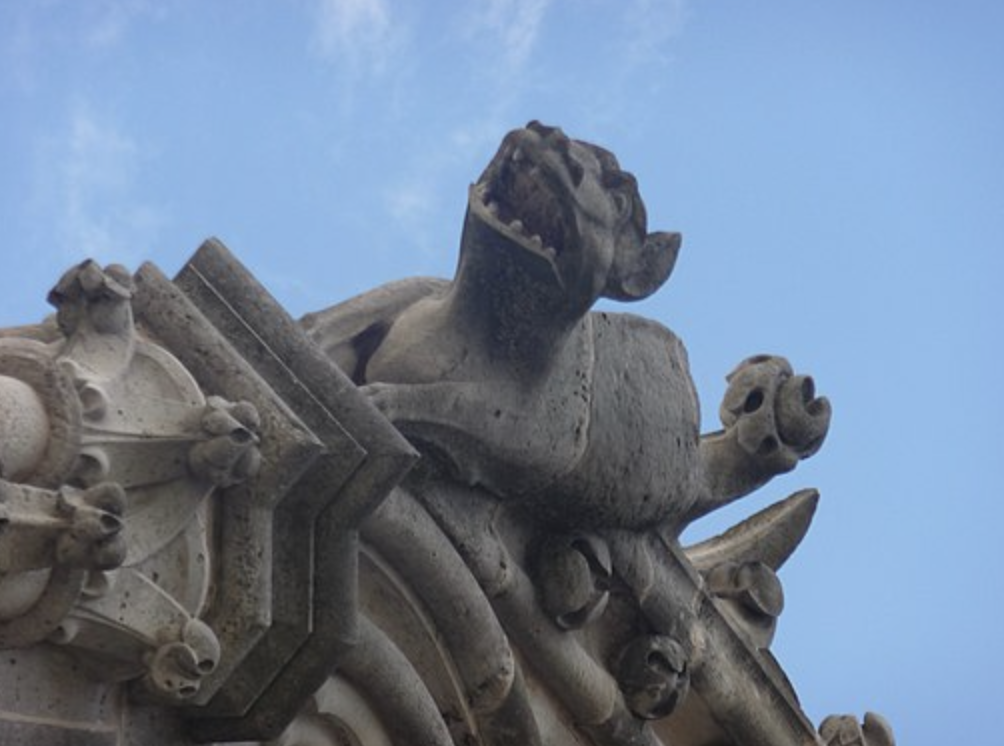
One of the classic gargoyles atop Notre-Dame, photographed in 2016. Image courtesy Marcok via Wikimedia Commons.
Who is the genius leading this team of experts? The man entrusted with this special renovation project is none other than famed architect Philippe Villeneuve. According to Paris’s Official Tourism site, Villeneuve’s plan from the get-go has been to “rebuild the cathedral identically, including the spire.” The architect’s mission to retain the building’s original structure seems to be the foundation from which all other decisions are made. Even so, some of the plans have departed from the Cathedral’s original design. This has caused quite a bit of drama. The reason for the drama is that, unsurprisingly, there have been a lot of opinions about how the phoenix of Notre-Dame de Paris should rise from the ashes.
The online rumor mill has added fuel to the fire. Last year, rumors surfaced regarding plans to depart from the Cathedral’s original plans, sacrificing austerity for new tech and additional features. This caused widespread concern among art experts and historians that the Diocese of Paris was attempting its own “woke Disney revamp.” Plans to create features such as “emotional spaces” and “a discovery tour” sparked French academics to doom the proposals as an example of “inanity [meeting] kitsch.”
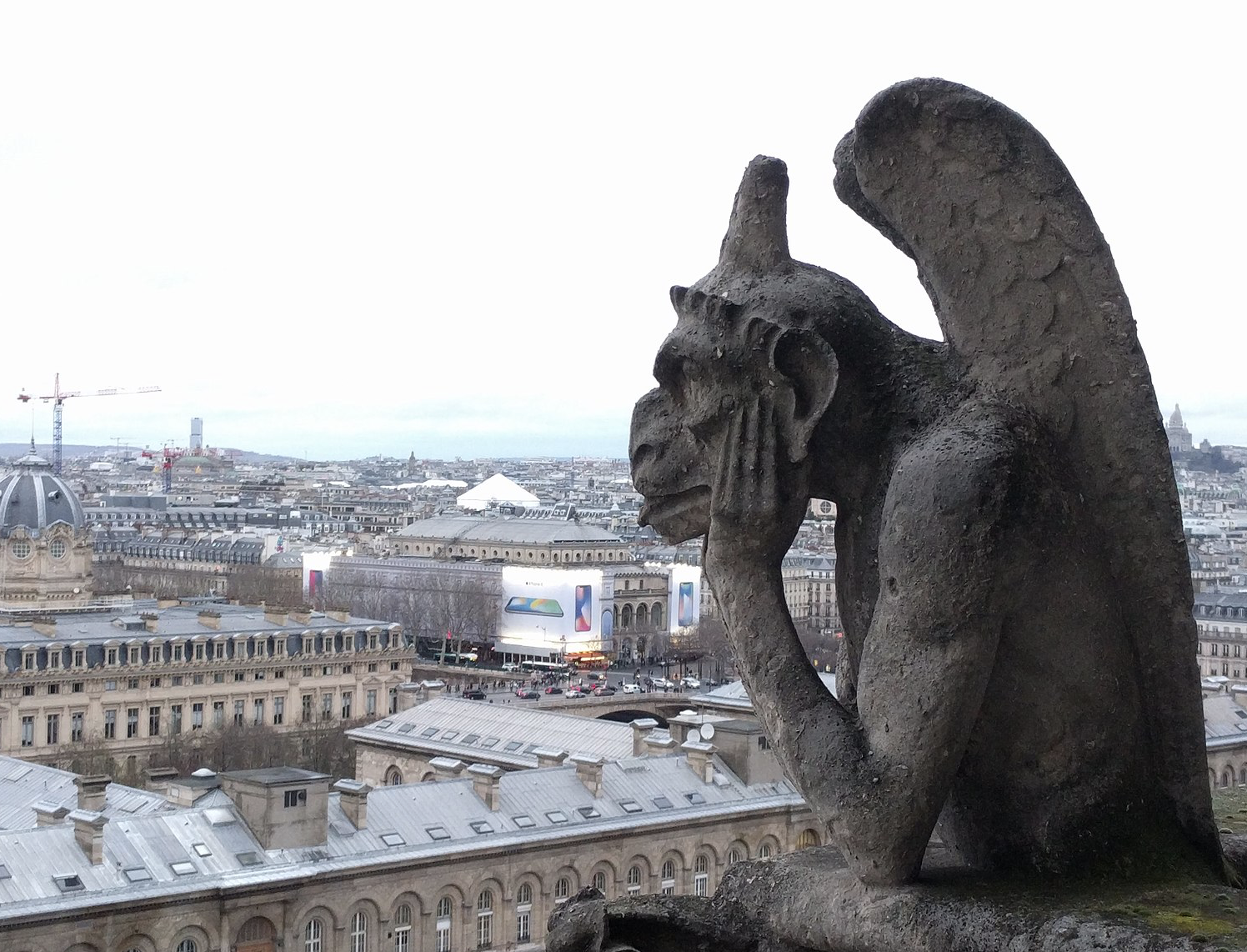
A contemplative gargoyle on the North Bell Tower in 2018, perhaps foreseeing the coming fire. Image courtesy Mari Doucet via Wikimedia Commons.
The “woke Disney revamp” comments ironically threw serious shade on the media powerhouse that brought new fame to Notre-Dame in the 1990s with the release of the animated film The Hunchback of Notre Dame. When approached for comment about the unfavorable comparison, Mr. Mickey Mouse chose not to respond. Those familiar with the matter claim that Mr. Mouse had suggested sending a “poop emoji” to the art historians’ to counter the vitriolic attack, but was dissuaded by publicity experts from doing so.
Despite criticism of any change from the original design, France’s National Heritage and Architecture Commission has approved several proposals integrating modern updates. These include installing modern lighting and contemporary works. Strong adherents to the traditional Gothic integrity of the space oppose such changes; on the other side, the Cathedral’s pastoral staff claim that some changes to the original plan will make the experience of visiting the Cathedral more enjoyable overall.
Additional controversial proposed changes favored by the Diocese include moving the tabernacle and other sacred objects. The purpose behind these changes is to encourage more of a dialogue between the visitor and the Gothic architecture of the sacred space when walking through the space. French authorities hope that these changes will retain the traditional feel of the original layout, while “bringing more a little more sense to the visitor.” As these changes seem directed at easing crowd flow for when the Cathedral is once again a major tourist site, they have faced fewer critics.
Lookout for the Spire
When word broke loose that there were plans to significantly change the monument’s overall architecture, the French Government got involved, to make sure that crucial elements of the Cathedral remain the same. At one point, a change to the iconic look of Notre-Dame was suggested in the form of a new, more modern spire. In response, President Emmanuel Macron intervened. He had been approached by cultural heritage experts who convinced him that a dramatic overhaul in design would drastically alter the integrity of the globally recognized monument. Macron stepped in to nix the change and prevent the 19th-century spire from being replaced with a more contemporary update. Reconstruction of the spire did not start until last year, because the monument itself had to undergo significant reconstruction to be able to support the 315 ft spire. True to his word, Macron has ensured that the new spire will match the one lost by fire. Those scanning the Parisian skyline will once again see the fabled towers in renewed glory.
A History of Renovations
Many people will be surprised to learn that the so-fought-for spire was not, in fact, part of the original 12th century Gothic design. The iconic Notre-Dame de Paris spire that the world knows and loves was added in the 19th century, by architect Eugène Voillet-le-Duc. Voillet-le-Duc’s involvement was the result of a major renovation effort at that time, spurred into life by renewed interest in the Cathedral following Victor Hugo’s famed tale.
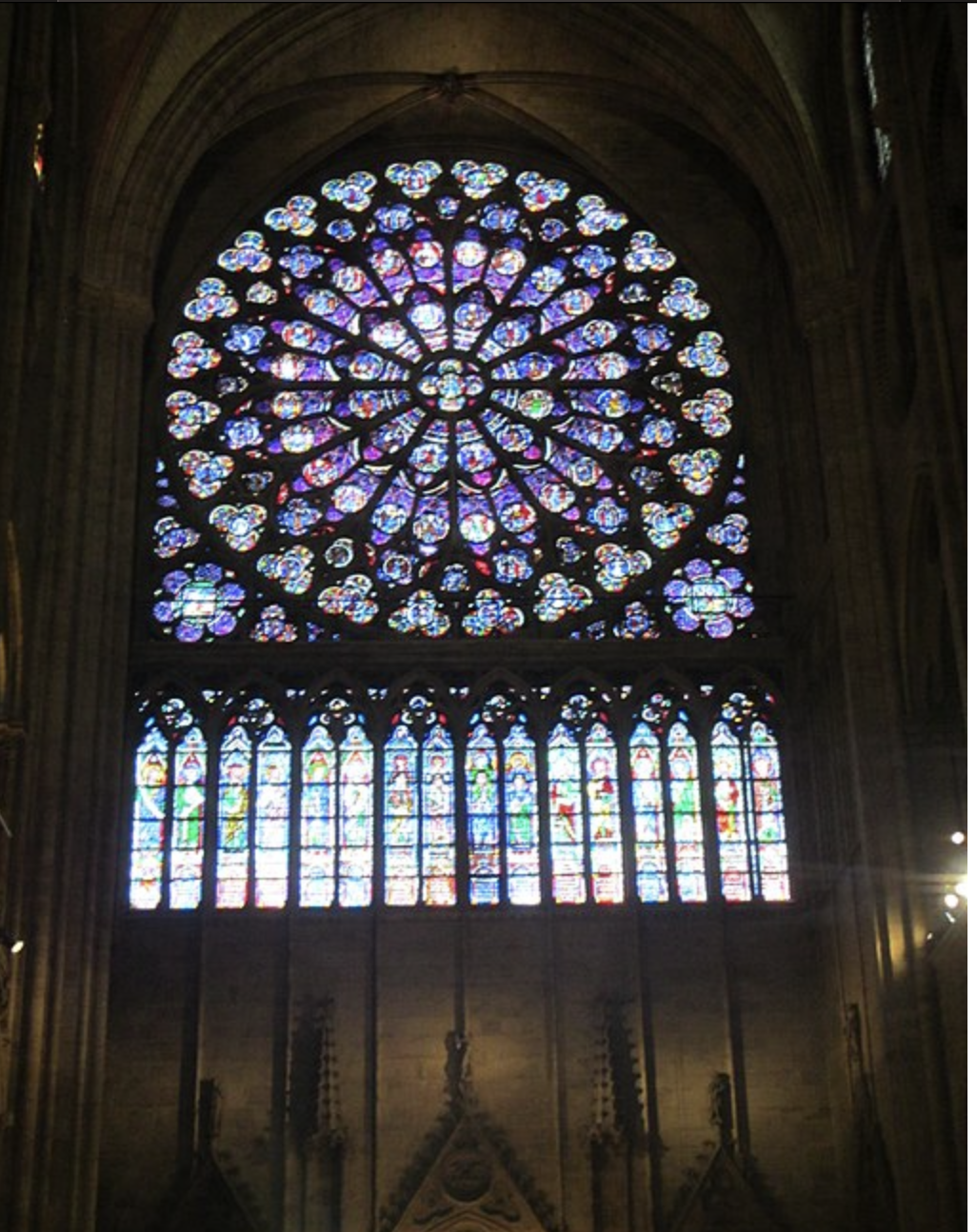
Notre Dame Rose Window in 2014. Image courtesy Jeremy Hylton via Wikimedia Commons.
That effort led by Voillet-le-Duc marked the most recent major renovation of Notre-Dame de Paris, but not its first major revamp. In 1699, the Cathedral received a major facelift in 1699, courtesy of the redecoration effort led by Hardouin Mansart and Robert de Cotte. Prior to that, several reconstruction and renovation efforts occurred, including the installment of the north and south rose windows.
In fact, the entire conception of Notre-Dame de Paris as we know it was the result of a major reconfiguration of sacred space. The original construction of Notre-Dame de Paris, commissioned by Bishop Maurice de Sully in 1163, replaced a demolished 4th century Cathedral of Saint Étienne. In that sense, one could argue that Notre-Dame de Paris has been an HGTV special from Day One.
The Future of Notre-Dame
Will this next reveal mark the final glow-up of this storied monument’s life? Or is this version of Notre-Dame de Paris simply another notch in the belt of this hero’s journey? If anything, this is a cathedral that has proved it knows how to reinvent itself and start anew. Plus, with the aid of new technology, the state-of-the-art Cathedral will be even more regal than before. Hopefully, 2019 was the last time Notre-Dame de Paris will face a fire. A renewed and refreshed cathedral will be worth the wait – and will stand for many centuries to come as a symbol of courage and resilience in the face of inferno.
by Amineddoleh & Associates LLC | Mar 21, 2023 |
 Our client, Christopher Bishop (owner of Christopher Bishop Fine Art), has acquired the premier art fair Master Drawings in New York (MDNY). The fair, held annually in January in New York City, focuses on works on paper and features several important galleries, as well as programs with leading institutions, including the Metropolitan Museum of Art, the Frick Collection, Christie’s, Sotheby’s, and the Hispanic Society Museum and Library. Christopher Bishop Fine Art, which specializes in drawings and paintings from the 15th through early 20th centuries, participated in MDNY for a decade, and Mr. Bishop was a former advisory board member to MDNY. With the acquisition of MDNY, Christopher Bishop Fine Art and Mr. Bishop have grown from exhibitors to organizers of this premier art fair.
Our client, Christopher Bishop (owner of Christopher Bishop Fine Art), has acquired the premier art fair Master Drawings in New York (MDNY). The fair, held annually in January in New York City, focuses on works on paper and features several important galleries, as well as programs with leading institutions, including the Metropolitan Museum of Art, the Frick Collection, Christie’s, Sotheby’s, and the Hispanic Society Museum and Library. Christopher Bishop Fine Art, which specializes in drawings and paintings from the 15th through early 20th centuries, participated in MDNY for a decade, and Mr. Bishop was a former advisory board member to MDNY. With the acquisition of MDNY, Christopher Bishop Fine Art and Mr. Bishop have grown from exhibitors to organizers of this premier art fair.
 We are proud to have worked with Christopher Bishop Fine Art during the past several years and to have served as legal counsel for this important acquisition. We are confident that MDNY will benefit from having Mr. Bishop at the helm of the institution, in no small part to his stellar reputation as a New York dealer who also has been successful in the European market. You can read more about the news in The Art Newspaper.
We are proud to have worked with Christopher Bishop Fine Art during the past several years and to have served as legal counsel for this important acquisition. We are confident that MDNY will benefit from having Mr. Bishop at the helm of the institution, in no small part to his stellar reputation as a New York dealer who also has been successful in the European market. You can read more about the news in The Art Newspaper.
by Amineddoleh & Associates LLC | Mar 6, 2023 |
“Continue to take all the risks and forever be curious.” – Shannon Riley, Co-founder of Building 180
In celebration of International Women’s Day, we are highlighting women in art history. Some readers may be unaware of the sheer number of working female artists during male-dominated artistic eras. If, for example, the Italian Renaissance only calls to mind the names of Ninja Turtles, and leaves out Italian Renaissance pioneer Fede Galizia, then this is a post to bookmark.
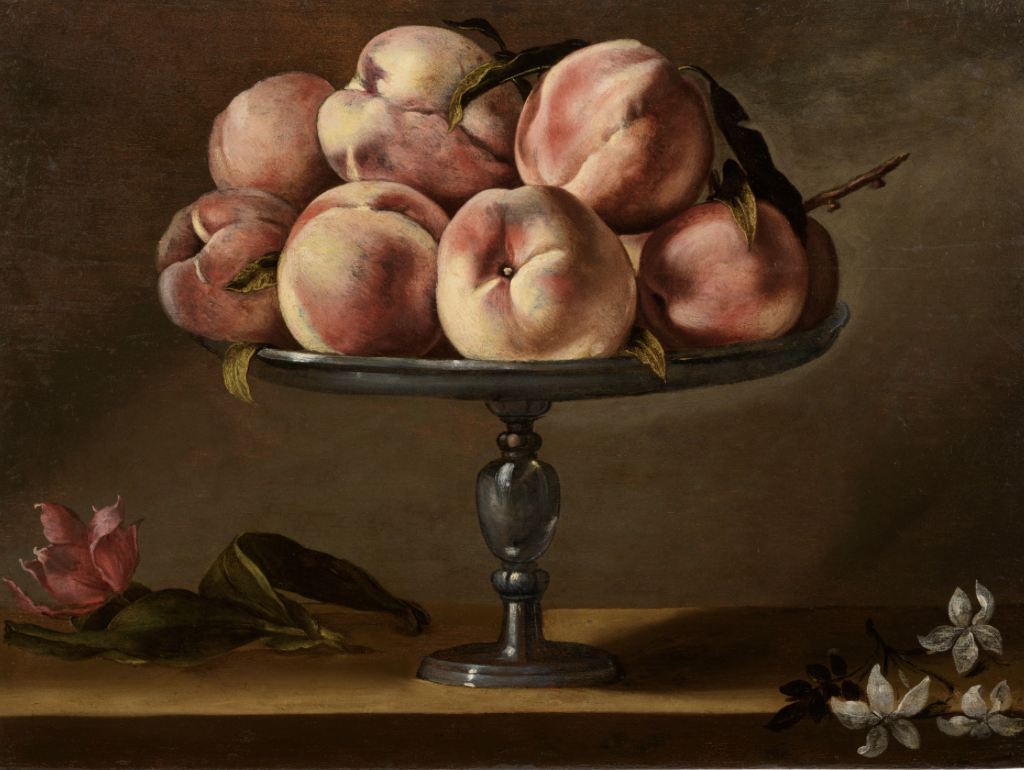
Fede Galizia (Italian, 1578–d. ca. 1630); Still life of peaches on a fruit stand with jasmine flowers and a tulip. Image obtained via artnet.com
Who was Fede? Not only the holder of an unusual name, which Microsoft Word is currently attempting to autocorrect to “FedEx,” but she was a female painter making strides in the art world alongside other Italian Renaissance greats. Her contribution to the still life genre may be compared with that of Caravaggio’s. Both were composing still lifes of fruit within the same decade – a rarity for this artistic era.
Details about Fede’s early life are few and far between, but it is likely that she faced societal pressures to prioritize domesticity over artistic training. But her knowledge of the household, gained by living with family throughout her childhood and early life, may have worked in her favor. It could be argued that her intimacy with domestic life gave her an edge in creating her iconic still lifes, over male counterparts like Caravaggio. If the men in her life thought that her obsession with making precise, detailed studies was “cute,” they were in for a surprise. Unbeknownst to them, this powerhouse of an artist was creating works that some critics today say surpass the skill and precision of her male counterparts. Her still life of peaches on a fruit stand with jasmine flowers and a tulip? Stunning. Take that, Caravaggio!
Fede also created distinctive miniatures, portraits, and altarpieces with incredible dedication to detail gleaned from her daily life. Her rendition of Judith with the Head of Holofernes, for example, purportedly features Judith as the self-portrait of the artist. The boldness required to use her own visage as inspiration speaks to the internal fortitude required for her to make art despite any societal pressures to engage more fully in domestic life.

Hildegard von Bingen, Scivias, 1151. Image distributed via DIRECTMEDIA in public domain.
Another historical standout is the one-and-only Hildegard von Bingen, largely regarded as the original female artist. Hildegard von Bingen was a woman in possession of the ultimate multi-hyphenate of a bio. Ready? She was an artist/composer/writer/Catholic mystic/scholar/modern-day Catholic saint/ and one of four female Catholic Doctors of the Church. She was a busy woman. In terms of her artwork, she is particularly known for her illuminated manuscript Scivias, (or “Know the Ways”), created around 1150. This manuscript contains illustrations of a mystical vision she had. The vision revealed the universe to her as a “round and shadowy” composition that was sheathed in an “outermost layer of a bright fire.” To Hildegard, this vision spoke to the breath of life awakening the universe. Her use of dramatic themes, and her openness with her own mystical visions, reveal a tenacity of a woman who was bold beyond the cultural norms of women of the time.
If either of the above artists’ stories are new to readers, join the club – many women artists have been written out of traditional art canons. As a result, even art history majors may not know of as many female artists as they do male ones. Sadly, many female artists simply failed to gain recognition, despite their talent and genius.

Sculpture in SoMo Village. Artists: Joel Dean Stockdill and Yustina Salnikova. Located in Rohnert Park, CA. Image via Building 180.
Fortunately, today, tides are turning, and there has been a renewed, concentrated effort to remember women in art across the ages. Our firm previously wrote an in-depth post on women and the rediscovery of women artists. Read it here. The efforts to recognize previous women artists are essential in crafting a more complete and cohesive global artistic narrative across genres, genders, and stereotypes.
As important as it is to remember those women artists of yesterday, we also celebrate women in the art world today. Women are making bold moves in the art world, as artists, scholars, patrons, and business entrepreneurs. Included in this group is the standout women-owned business Building 180.
Building 180: Finding a Space & Filling a Need
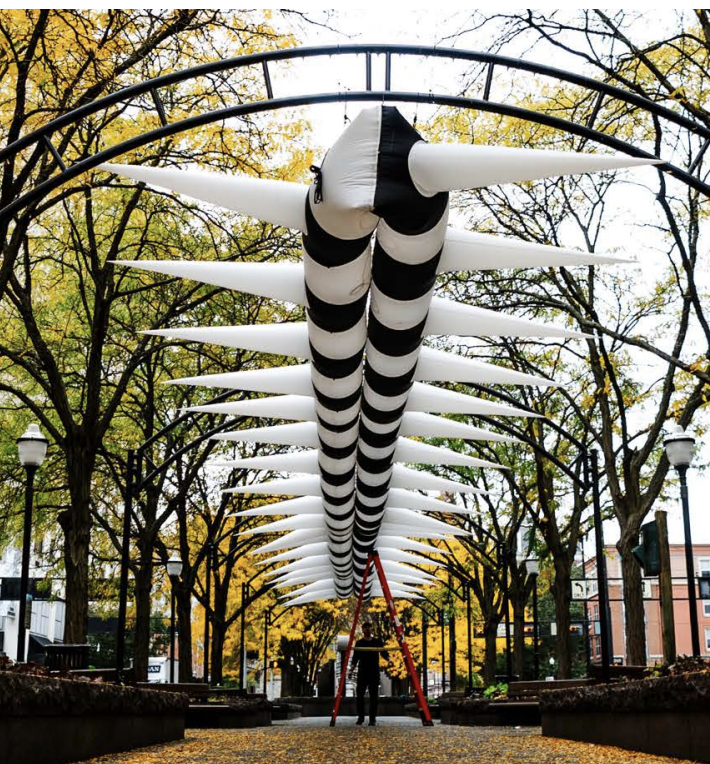
Bee Line sculpture installed for Piatt Park. Artist: Inflatabill. Located in Cincinnati, OH. Image via Building 180.
Building 180 is a full-service global art production and consulting agency. The company fills the gap between artists and businesses to create public and private art installations in the form of murals, sculptures, and interiors. “Full-service” here means “full-service”: Building 180 handles the design, curation, and production of art installations from conception to completion. This includes budgeting, contracting, artist selection, fabrication, shipping, and management. Building 180 really shines in its role as intermediary, by streamlining communication between artists and site owners to make a smooth installation of the artwork (whether permanent or temporary).

IT interior created for Twitch. Muralist: The Tracy Piper. Located in Los Angeles, CA. Image via Building 180.
Think of Building 180 as the Fairy Godmother of Cinderella’s art world: giving oft-overlooked artists their Glass Slippers and sparkly pumpkin carriage to arrive at the ball. Building 180 provides artists with the essentials needed to bring forth their best work, while simultaneously handling the often overwhelming logistical and business aspects of large-scale installations. The result is an open, approachable, communal experience of art living alongside viewers in the everyday.
The need for a business such as Building 180 cannot be undervalued. Contrary to popular belief, murals, sculptures, and gorgeous interiors do not simply appear overnight. They require attention to detail at all stages of the transaction. Because Building 180 orchestrates the installation from start-to-finish, working with both artists and business owners, the company makes the murky waters of bringing art to life in unexpected places not only possible, but peacefully navigable.
Bringing Art to the Community

Muralists stand back to gauge their work for Paint the Void. Image via Building 180.
At the heart of Building 180’s mission is to bring art to the community through strategic efforts to foster engagement and inclusivity. These goals are achieved through educational programming, invitations for project volunteers, and panel discussions aimed at identifying the needs and desired outcomes for the community.
The premier example of Building 180 bringing art to the community in an effective and mindful way occurred in the early stages of the pandemic lockdowns of March 2020. Paint the Void, Building 180’s non-profit, is the public mural initiative founded in early 2020. The goal of the organization? Commission artists to complete public murals using the plywood covering closed storefronts and windows of boarded-up businesses. The result has been a completion of over 230 murals. Building 180 partnered with over 35 different neighborhoods to install the works. In doing so, Building 180’s brilliant team has supported over 175 small businesses, engaged the help of over 2,000 volunteers, and seen 250 artists paid for their work.
A ”snapshot” of this mural movement was recently on display in San Francisco, in the form of a retrospective. The City Canvas: A Paint the Void Retrospective featured 49 pieces from Paint the Void, including Nora Bruhn’s Keep Blooming, a pastel-colored floral that covered the boarded-up storefront of restaurant Chez Maman.
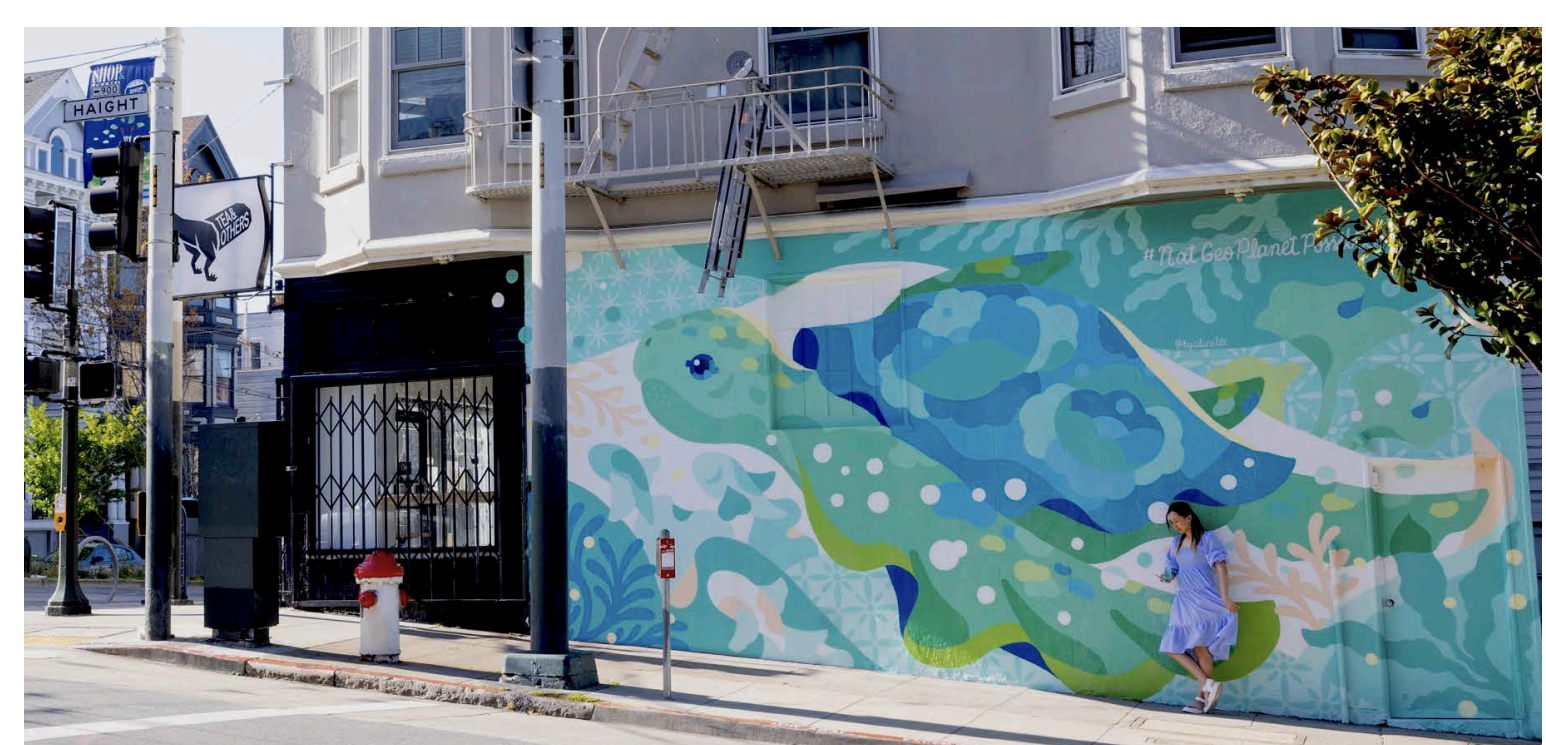
Save the Turtles painted for National Geographic. Artist: Alice Lee. Mural located in San Francisco, CA. Image via Building 180.
Bruhn’s piece is a fantastic example of the fundamental impact of the mural movement, and of Building 180 as a whole: to release the artistic power held within the daily lives of local communities. Building 180 accomplishes this impeccably, by marrying artists with businesses to find available space for art. These creative solutions employ artists and create economic opportunities for business owners – all while serving to spark the imaginations of all who encounter the works. The result? Communal resiliency and a deeper fascination with the power of art.
by Amineddoleh & Associates LLC | Mar 1, 2023 |
What is it about children and their love of toy dolls? The iconic American Girl Dolls continue to take center stage in American childhoods, alongside another classic doll: the one and only Barbie doll. For some Americans, Barbie dolls feature in every memory of their childhood.
The connection to dolls, formed in childhood, may linger into teenage and adulthood years. In fact, those who grew up toting Barbies everywhere are likely the adults eagerly anticipating this summer’s blockbuster film of the same name. It’s a safe bet that the new promo for Greta Gerwig’s Barbie movie, starring Margot Robbie as Barbie, has danced across their phone screens. The short teaser clip, released last month, has already banked over eight million views on YouTube, through the Warner Brothers’ official YouTube handle.
In Japan, young children also have a special relationship with dolls. However, for Japanese girls, the dolls are not Barbie dolls. Instead, they are ones displayed each year during a holiday known as Hinamatsuri.
Traditional Japanese Holiday: Hinamatsuri
The Hinamatsuri, or what is known as the “Girls’ Festival,” is a special day for families with daughters. On this day, March 3rd, Japanese families who have daughters celebrate them by presenting them with beautiful dolls, called hina-ningyo, in a dollhouse-like display. The beautiful arrangement is then adorned with fresh peach blossoms. These pink blooms are the fauna associated with the holiday. Their purpose is to ward off evil spirits, as the families wish their daughters success and happiness in their lives.

Natsuko Suwa as a child, standing in front of her dolls on Hinamatsuri. Image courtesy of Natsuko Suwa via Japanese Culture Exchange.
Hinamatsuri celebrations began in Japan during the ancient Heian Period (794-1192) with paper and straw dolls. This changed during the Edo Period (1603-1868). At that time, the dolls began to be made of a combination of ceramic and fabric. The dolls themselves became more central to the celebration during this time, possibly because of the heightened attention to the craftsmanship of the dolls themselves.
Originally, only two dolls were used in the festival: a bride doll (representing the empress) and a groom doll (representing the emperor). These two dolls are still important to modern Hinamatsuri displays in Japan. Parents typically purchase these two figures for their daughters after she is born. Because the dolls can be very expensive, another option for some households is to pass dolls down through female family members.
Displays of hina-ningyo dolls can be intricate and include more than just the two original dolls. After the Edo period, the most prestigious sets consist of seven platformed layers. Today, it is more common for households to display one-to-three layered sets of Hinamatsuri dolls. In these expanded displays, the additional layers provide room for a wide variety of royal court attendees, including three court servants (San-nin Kanjo) and five boy musicians (Go-nin Bayashi). Other layers are added, to ensure that the display contains seven layers in total, for good luck. Miniatures typically take the spotlight on these lower layers. Some may also have small versions of traditional Japanese tea sets or Japanese musical instruments.
Dining with Dolls
The traditional foods of Hinamatsuri are as alluring and aesthetically delicate as the dolls themselves. In preparing these foods, and serving them to share, Japanese families engage in the social practice of Washoku. Washoku is an intangible cultural heritage tradition, recognized in 2013 by UNESCO on the Representative List of the Intangible Cultural Heritage of Humanity (8. COM).
UNESCO defines Washoku as “a social practice based on a set of skills, knowledge, practice and traditions related to the production, processing, preparation and consumption of food.” Washoku is typically associated with Japanese New Year celebrations, the three-day holiday known as Oshogatsu. However, the practice itself extends beyond the Oshougatsu celebration, and is seen in traditional Japanese meals all throughout the year. In fact, the Kanji characters used to write the word “Washoku” are comprised of two characters, the literal translation of which is “Food of Japan.” As a result, visitors to Japan will experience Washoku during any traditional Japanese meal, whether it occurs on a holiday, such as Hinamatsuri, or not.
The practice of Washoku involves making beautiful dishes using symbolic ingredients to communicate specific wishes and blessings during the meal. The skills used to make each symbolic dish, including the proper methods, seasoning, and artistic decorations, are passed down within Japanese households through families. In this way, the cultural preservation of these techniques is accomplished by informal training methods, though formal cooking techniques for these dishes are also taught at culinary schools in Japan. This practice is done in a gorgeous fashion during Hinamatsuri.
What are the foods eaten at Hinamatsuri, preserved through Washoku? The beautiful cuisine traditionally served during Hinamatsuri communicates meaning that matches this special occasion. Hishimochi, a tri-colored rice cake, takes center stage at Hinamatsuri celebrations in Japan. Traditionally made of three, pastel-colored layers of cake, the diamond-shaped cake is typically displayed alongside the dolls. The pink, white, and green layers of rice cake symbolize Sakura blossoms, snow, and new growth. Taken together, the entire cake represents fertility, and is meant to promote good fortune for the daughter who takes a delicious bite.
The same color palette appears in another delicate traditional food on this day: hina arare, or colored rice crackers. Hina arare are sugar-coated puffed rice crackers dyed in pink, green, yellow, and white.
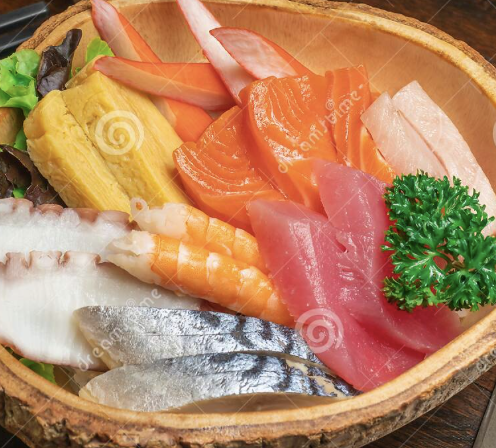
An artful display of Chirashi-zushi, or scattered sushi. Image via Schwin Pikulsawad at Dreamstime.com.
Chirashi-zushi, or scattered sushi, makes up the day’s entrée. This light assorted dish is composed of sweetened sushi rice and ingredients that are consistent with the colors of Hinamatsuri. These ingredients differ; an example of toppers for the sweetened sushi rice that are commonly used are pink shrimp for longevity, beans for steady health, and lotus root for the ability to see ahead.
One dish that does not include the Hinamatsuri colors, but that still holds meaning, is hamaguri no osuimono, a clear soup made of clams. Clams are in season in the beginning of March in Japan. The shells themselves symbolize a happy union in marriage, as the unique joined shells fit together in harmony.
To drink, the girls drink a small portion of toukashu, a sweet, rice wine with peach blossoms floating in it. Peach blossoms have always been known to ward off evil spirits in Japan, so this is the perfect beverage for this special holiday.
Artistry of Hina-Ningyo
The artists who create hina-ningyo dolls have artisan workshops in Japan, and they rely on techniques that have been passed down through artists for centuries. Typically, employees at these workshops will construct the doll pieces separately. The next step is to deliver all the individual doll parts to the shop’s master artist, who will then spend as many as five days constructing just one single hina-ningyo doll.
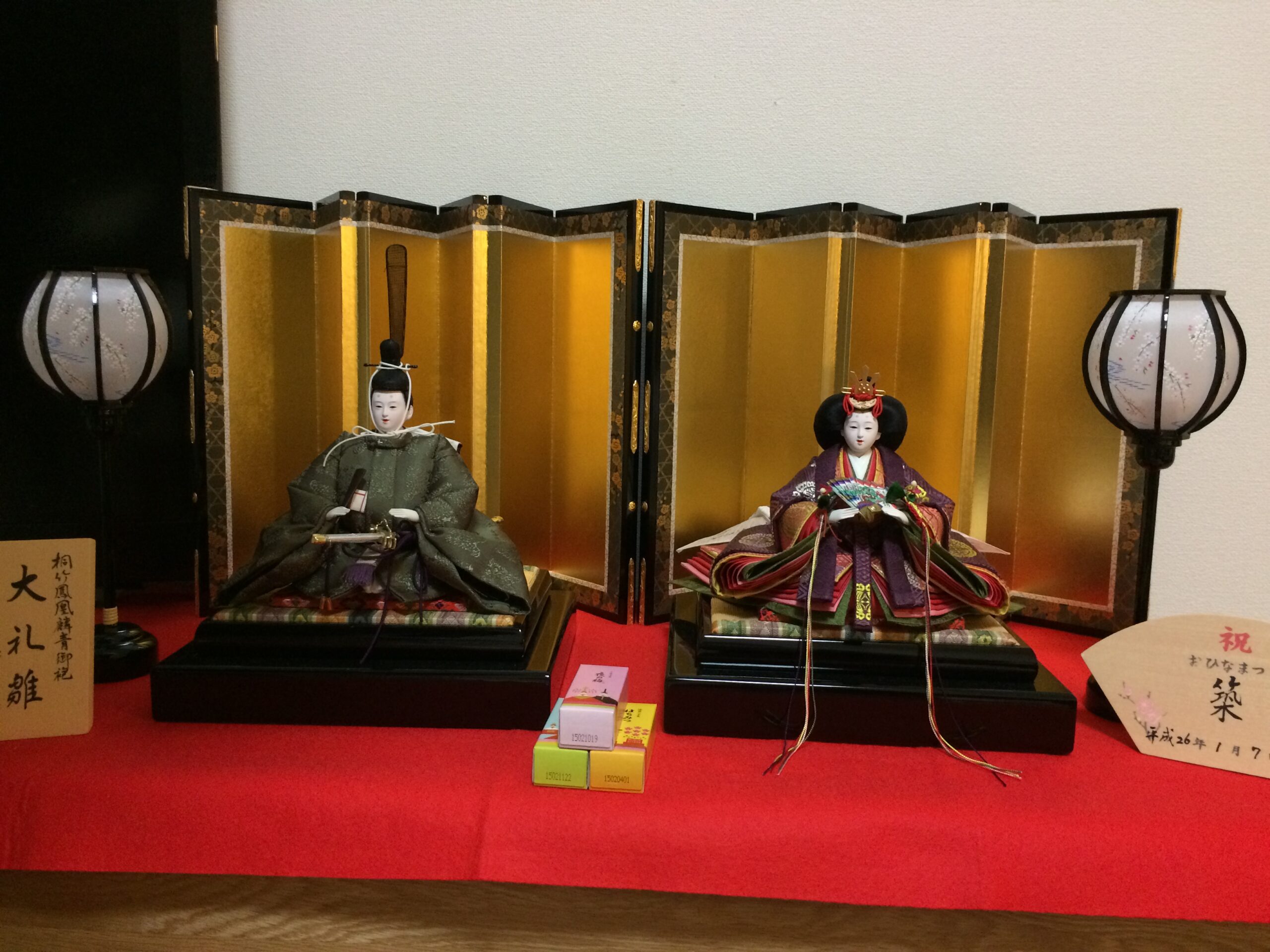
Two hina-ningyo dolls on display. Image courtesy of Natsuko Suwa via Japanese Culture Exchange.
The time and energy spent in the workshops that produce authentic hina-ningyo dolls in Japan is a testament to the importance of this holiday in Japan, as well as to the sacredness of these dolls in the lives of Japanese households. Originally, it was believed that each hina-ningyo doll had the ability to absorb evil spirits. This belief stemmed from ancient tradition, in which the third day of the third month was deemed a day of purification. To purify the household and promote a healthy future, the custom was to transfer evil spirits into dolls. The dolls were then sent on boats downstream to release the bad spirits rivers and oceans. This custom was called hina nagashi.
Today, custom has shifted, and dolls are instead displayed on the ornamental, tiered structures discussed above. This way, the beautiful craftsmanship of the dolls is preserved, while still respecting the original, sacred purpose of hina-ningyo dolls.
Are Hina-Ningyo Dolls Copyrightable?
Legal eagles among us may see such breathtaking artistry and wonder: are dolls of this type copyrightable? With this level of craftsmanship and creativity on the line, what level of intellectual property protection may be available to artists?
U.S. caselaw is instructive on this point. Although many aspects of a doll may not be copyrightable under the Copyright Act, some elements of each hina-ningyo doll may be copyrightable by the artist, if they are sufficiently original. This may result in only minor copyright protection for a hina-ningyo doll master, but it could provide some protection, if the facial expression or certain design elements of the doll’s clothing are sufficiently distinctive.
The closest case on point is likely Satava v. Lowry, a 9th Circuit decision in which two artists created similar sculptures of jellyfish enclosed in glass. Richard Satava, a California-based glass artist, became famous for his iconic glass-in-glass sculptures of jellyfish. His sculptures – which are still being produced – sell for thousands of dollars. At the time of the lawsuit, he was regularly making upwards of 300 sculptures per year. Several of his works had been registered with the Register of Copyrights, and (perhaps even more telling) many consumers could identify his works on-sight, due to their signature design.
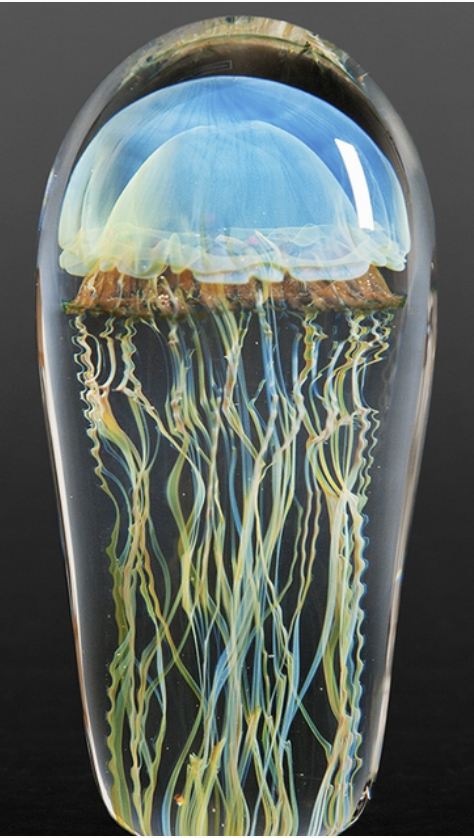
Jellyfish sculpture created by Richard Satava. Image obtained via satava.com.
Defendant Christopher Lowry, a Hawaii-based glass artist, separately began making glass-in-glass sculptures of jellyfish. Lowry’s designs were so similar to Satava’s that consumers confused the works by the two artists. Satava sued Lowry, demanding an injunction, which the district court granted. Lowry then appealed, arguing that Satava did not have a protected copyright over the jellyfish sculptures.
The court reviewed different elements of the sculptures to determine whether or not the defendant had infringed on the Satava’s designs. In reviewing the pieces, the court came away with a list of elements that could be copyrightable, and those that could not.
According to the 9th Circuit, the elements deserving copyright protection were unique colors, shapes, and lines that were unlike a jellyfish’s natural depiction. This stems from the reasoning that the artists’ decisions in creating more fanciful renditions or interpretations of jellyfish speak to the originality requirement at the heart of the Copyright Act. In contrast, the elements of the sculpture that were not copyrightable were the ones that mirrored a jellyfish in its natural habitat. This included features such as jellyfish bells and tentacles, and the jellyfish’s suspension in glass, imitating its movement in water.
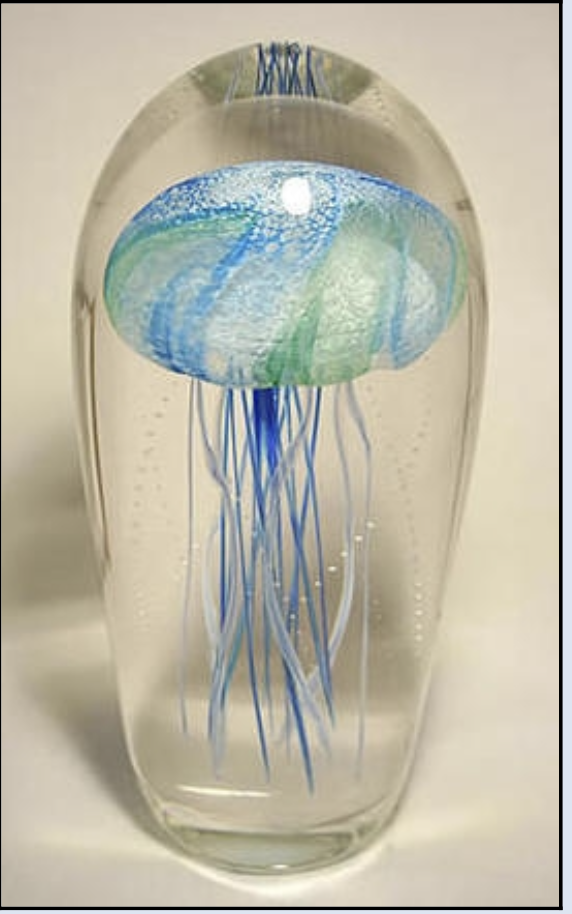
A jellyfish sculpture by artist Christopher Lowry, currently for sale. Image obtained via artglassbygary.com.
After examining each sculpture, the outcome of this case was a bit surprising. The court found for Lowry, holding that he could not be prevented from creating jellyfish sculptures similar to Satava’s. Even though the artists’ sculptures were similar, Satava failed to supply sufficient proof that Lowry had copied the protectable design elements of Satava’s work.
What would have changed the outcome of that case? This was a close case, and the outcome hinged on the 9th Circuit’s application of the originality test. To be fair to Lowry, Satava’s sculptures are – in essence – realistic-looking jellyfish in a kind of upside-down dome. It is entirely possible that Lowry could have (and likely did) come to create his own version of jellyfish in an upside-down elongated jar, completely by his own faculties. Moreover, Lowry lived in Hawaii, literally by fish and aquatic themes, ripe for applying to his glasswork. Is it any surprise that the jellyfish-in-a-jar idea came to him, as well?
On the other hand, Satava had established a reputation for himself for creating iconic jellyfish sculptures. The sculptures were popular with and recognizable to art lovers across the country. Additionally, consumers actually confused Lowry’s pieces with Satava’s highly sought-after work. In the end, the court held that the protectable elements of Satava’s work – such as unique lines, shapes, and color combinations – had not been infringed upon.
Perhaps if Lowry had made outright replicas of Satava’s work, the 9th Circuit would have upheld the district court’s injunction against Lowry. This is what happened in Mattel, Inc. v. Goldberger Doll Mfg. Co., where the Second Circuit Court of Appeals analyzed a copyright infringement claim by Mattel against another doll manufacturer.
In Mattel, the defendant, Radio City Entertainment, created a doll to celebrate the famed Rockettes for the 2000 millennium festivities. Mattel brought suit against Radio City, arguing that their Rockettes doll infringed on their registered copyrights for two separate Barbie dolls: “Neptune’s Daughter Barbie” (registered in 1992) and “CEO Barbie” (registered in 1999). Mattel argued that Radio City had essentially combined the features of those two registered dolls to produce the Rockette doll, in a Frankenstein-esque fashion. Radio City moved for summary judgment, which the district court granted. For the purposes of summary judgment, the district court held that Radio City had copied the Mattel Barbies’ “eyes, nose, and mouth,” but that Mattel had no copyright in those “common elements” of a “youthful female doll.” The court went on to identify those unprotectable elements as “full faces; pert, upturned noses; bow lips; large, widely spaced eyes; and slim figures.”
Here is where this case gets tricky: because the district court had, for the purposes of summary judgment, already held that the Rockette doll had copied the Barbie dolls’ eyes, nose, and mouth, but that Mattel had no copyright in those elements, the remaining similarity determination was made without including the face. As a result, the district court found for Radio City.
Mattel appealed to the 2nd Circuit. On appeal, the 2nd Circuit held that the district court’s conclusion that the eyes, nose, and mouth of the Barbies were not protected by copyright was erroneous. The 2nd Circuit applied the originality test with a lower bar than the 9th Circuit in Satava. Here, the 2nd Circuit held that the Barbies’ faces, despite containing common elements, had satisfied the “minimal degree of creativity or originality” necessary to obtain copyright protection. The court went on to explain that such protection in facial features – particularly for a doll of a certain type – is limited. Some features, common amongst the Disney princess set (wide eyes, upturned nose, bow lips), compose an idea of a face that belongs to the public domain. However, on these facts, the 2nd Circuit held that Mattel’s copyright extended to the particular expression of the Barbie faces.
As a result, the 2nd Circuit remanded the case back for further proceedings. In response, the parties entered into a settlement agreement, and litigation ceased. These two cases are similar, but yielded dramatically opposite outcomes. What distinguishes these two cases from each other?
The answer may simply boil down to the discretion of the court, and the originality test the court applies based on the facts at issue. The outcomes in these two cases illuminate the difficulty of applying the U.S. Copyright Act and copyright case law, particularly when modern culture influences a judges’ definition of what “counts” as artistry, creativity, and originality. It raises the question of whether or not precedent is the most uniform way to understand the Copyright Act. Perhaps it is time copyright protections in the U.S. benefited from some clearer legislation.
Moreover, and particularly applicable in the Mattel case, the court seemed to base its originality determination on what is culturally considered a “doll face” and a “doll body” using a (now dated) set of criteria. In 2023, such a list of elements read as discomfortingly patriarchal. It calls to question whether the same court would apply the same test differently today, based on the modern introduction of a wider selection of popular Barbie dolls. Does the social and cultural movement toward embracing multiple body types, skin tones, and diverse faces change the way a court approaches the originality test for dolls?
Rights of Artists
For artists creating hina-ningyo dolls, lingering questions mean that some aspects of the dolls may be copyrightable, while others are not. This does not give much copyright protection to the artist. But artists may still be protected from another artist flat-out replicating their work under the Copyright Act. Doll artists around the world who seek to protect their work might consider focusing on their dolls’ exact proportions, composition of facial features, and recognizable design elements when they consider registration. Even so, registering specific doll elements may not fully protect the artists’ work from infringement, because, under the current legal landscape, the exact test for originality turns on the interpretation of the sitting court.

Suwa’s display of dolls on Hinamatsuri. Image courtesy of Natsuko Suwa via Japanese Culture Exchange.
Role of an Art and Cultural Heritage Lawyer
Staying abreast of important holidays in other cultures is an essential component of any art and cultural heritage law attorney’s work, because knowledge of local celebrations fosters understanding and connection with new groups of people. To study Hinamatsuri, for example, is to become a student of the deep love present within Japanese families. A day set aside to celebrate daughters? Filled with delicate pastries, pastel colors, and prized doll collections? Count this writer in.
Cultural information for this post was aided by Natsuko Suwa. Suwa is an instructor at Japanese Culture Exchange, a language school located in Raleigh, NC that offers virtual and in-person language lessons.











 Our client, Christopher Bishop (owner of Christopher Bishop Fine Art), has acquired the premier art fair Master Drawings in New York (MDNY). The fair, held annually in January in New York City, focuses on works on paper and features several important galleries, as well as programs with leading institutions, including the Metropolitan Museum of Art, the Frick Collection, Christie’s, Sotheby’s, and the Hispanic Society Museum and Library. Christopher Bishop Fine Art, which specializes in drawings and paintings from the 15th through early 20th centuries, participated in MDNY for a decade, and Mr. Bishop was a former advisory board member to MDNY. With the acquisition of MDNY, Christopher Bishop Fine Art and Mr. Bishop have grown from exhibitors to organizers of this premier art fair.
Our client, Christopher Bishop (owner of Christopher Bishop Fine Art), has acquired the premier art fair Master Drawings in New York (MDNY). The fair, held annually in January in New York City, focuses on works on paper and features several important galleries, as well as programs with leading institutions, including the Metropolitan Museum of Art, the Frick Collection, Christie’s, Sotheby’s, and the Hispanic Society Museum and Library. Christopher Bishop Fine Art, which specializes in drawings and paintings from the 15th through early 20th centuries, participated in MDNY for a decade, and Mr. Bishop was a former advisory board member to MDNY. With the acquisition of MDNY, Christopher Bishop Fine Art and Mr. Bishop have grown from exhibitors to organizers of this premier art fair. We are proud to have worked with Christopher Bishop Fine Art during the past several years and to have served as legal counsel for this important acquisition. We are confident that MDNY will benefit from having Mr. Bishop at the helm of the institution, in no small part to his stellar reputation as a New York dealer who also has been successful in the European market. You can read more about the news in
We are proud to have worked with Christopher Bishop Fine Art during the past several years and to have served as legal counsel for this important acquisition. We are confident that MDNY will benefit from having Mr. Bishop at the helm of the institution, in no small part to his stellar reputation as a New York dealer who also has been successful in the European market. You can read more about the news in 











